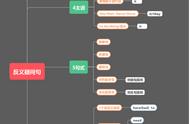反意疑问句
反意疑问句是由一个陈述句与一个简短的一般疑问句(又称附加问句)构成,中间用逗号隔开。反意疑问句有两种句式:“肯定,+否定?”和“否定,+肯定?”。·Alice stayed up late last night, didn't she?
爱丽丝昨晚熬夜到很晚,是吗?
She doesn't like English ,does she?
她不喜欢英语,对吗?
特殊的反意疑问句形式:
(1)陈述部分的主语是I,疑问部分要用aren't I.
·I'm as tall as your sister,aren't I?
我和你姐姐一样高,对吗?
(2)陈述部分的主语是指示代词this,that或不定代词everything,anything,nothing等时,疑问部分的主语用it.
·This is a great party,isn't it?
这是一个很棒的聚会,对吗?·Everything goes well with you,doesn't it? 你一切顺利,是吧?
(3)陈述部分的主语是不定代词everybody,anyone,somebody,someone,nobody,no one等时,疑问部分的主语强调全体时,用they;强调个体时,用he.
·Everyone knows the answer, don't they? /doesn't he?
人人都知道答案,是这样吧?
(4)陈述部分是there be结构时,疑问部分的主语仍用there.
·There is little water in the lake,is there?湖里几乎没有水,是吗?
(5)陈述部分有 no,never,few,seldom,hardly,litle等具有否定含义的词时,疑问部分用肯定形式。·They seldom have lunch at school, do they?
他们很少在学校里吃午饭,对吗?
注意:
否定前缀不能视为否定词,其疑问部分仍用否定形式。
It is impossible, isn't it?
这不可能,是吗?
(6)含有定语从句、宾语从句的主从复合句,疑问部分的主语和谓语通常与主句一致。
·He said he would come here the next day,didn't he?
他说他第二天来这儿,是吗?
(7)陈述部分主句的主语为第一人称,谓语动词为think,believe 等后接宾语从句时,疑问部分与宾语从句相对应,但要注意从句中的否定转移现象。
We believe she can do it better,can't she?我们相信她能做得更好,是吗?
I don't think he likes playing football,does he?
我认为他不喜欢踢足球,对吗?
(8)祈使句的反意疑问句,疑问部分用will you;以Let's开头的祈使句,疑问部分用 shall we;以Let us开头的祈使句,疑问部分用will you.
·Don't do that again,will you?
别再那样做了,好吗?
·Let's go to the cinema,shall we?
我们去看电影,好吗?
·Let us wait for you in the reading room,will you?
我们在阅览室等你,好吗?















